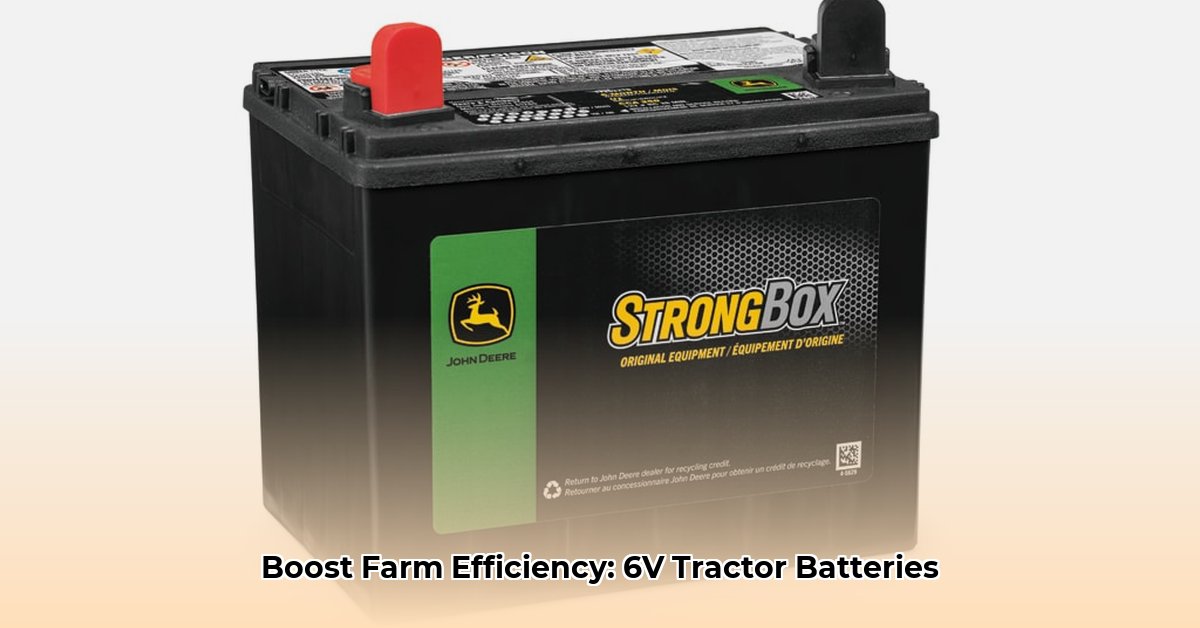
Keeping your farm equipment running smoothly depends on reliable power, and that often starts with a dependable 6-volt battery. Tractor Supply offers a variety of options, but choosing the right one can be challenging. This comprehensive guide will help you select, install, maintain, and troubleshoot 6-volt batteries, ensuring your farm operations remain efficient. For more information on marine batteries, check out this helpful resource: Tractor Supply Batteries.
Decoding the World of 6-Volt Batteries: Lead-Acid and Beyond
Most 6-volt batteries at Tractor Supply are lead-acid, the workhorses of the agricultural battery world. They're known for reliability and affordability. However, even within lead-acid, there are variations:
Flooded Lead-Acid (FLA): These traditional batteries require periodic checks of the electrolyte (fluid) level and topping off with distilled water. While less expensive, this requires more hands-on maintenance. Think of it like regularly checking your tractor's oil—a small effort for big results.
Maintenance-Free: These batteries are sealed, minimizing the need for water replenishment. They offer enhanced convenience and often longer lifespans, but come at a higher initial cost. Which one's right for you? It depends on your priorities: cost versus convenience. Do you value saving money upfront, or do you prefer the ease of a maintenance-free design?
Beyond lead-acid, emerging technologies like lithium-ion may offer advantages in the future. Though less prevalent currently at Tractor Supply, their higher energy density and reduced maintenance could make them a viable option for future farming needs.
Choosing the Right Battery: Key Specifications
Selecting the correct battery is crucial for optimal performance. Your equipment's owner's manual is your bible; it specifies the necessary battery characteristics. Look for these key specifications:
Reserve Capacity (RC): This indicates how long the battery can power accessories (like headlights) with the engine off. Higher RC is preferable— providing more operational time if a starting issue arises. A higher RC offers a larger safety margin.
Cold Cranking Amps (CCA): This measures the battery's power output in cold temperatures. If you experience harsh winters, a higher CCA guarantees reliable starts even on frigid mornings. A farmer in northern Minnesota will need a much higher CCA than one in southern Texas.
Group Size: This refers to the physical dimensions of the battery. The group size must match your equipment. Forcing a mismatched battery into the tray can damage both your battery and your equipment.
Ignoring these specifications can lead to reduced performance and potential equipment damage. Always cross-reference your chosen battery with your equipment's manual.
Finding the Right Specs: Utilizing Your Equipment's Manual
Your equipment's manual provides crucial battery specifications: group size, CCA, and RC. Referencing this information ensures the perfect match for your machinery. Don’t hesitate to consult Tractor Supply staff if your manual is unclear or unavailable; they are a valuable resource.
Step-by-Step Battery Installation
Safety is paramount during battery installation. Always follow these steps, but remember to consult your equipment's manual for any model-specific instructions:
Safety First: Begin by disconnecting the negative (-) terminal of the old battery to prevent accidental shorts.
Removal: Carefully remove the old battery, noting the securing straps or clamps.
Clean Terminals: Remove corrosion from the battery terminals using a wire brush or terminal cleaner. This ensures efficient current flow.
Installation: Secure the new battery firmly in its tray.
Connection: Connect the positive (+) terminal, followed by the negative (-). Double-check that all connections are secure and corrosion-free.
Maintaining Your Battery: Extending Lifespan
Proactive maintenance extends battery lifespan. Follow these simple tips:
Regular Inspections: Inspect the terminals for corrosion. Clean them as needed. (A simple wire brush is all you need!)
Electrolyte Level (FLA Batteries): Check the electrolyte level in FLA batteries regularly and add distilled water (never tap water!) as needed.
Keep it Clean: Keep the battery clean and dry to prevent premature wear.
Avoid Overcharging: Overcharging can damage the battery. Follow charger manufacturer instructions precisely.
Troubleshooting Common Problems: Identifying Issues
Experiencing starting problems? Consider these possibilities before replacing the battery:
Corrosion: Clean corroded terminals thoroughly.
Low Electrolyte (FLA): Check and top off the electrolyte level in FLA batteries with distilled water.
Sulfation: This build-up on battery plates reduces capacity. A battery charger may resolve this, but severe sulfation likely requires replacement.
Battery Failure: Unfortunately, despite best efforts, batteries eventually fail. Replacement is the most efficient solution.
Comparing Battery Types: A Summary
| Battery Type | Advantages | Disadvantages |
|---|---|---|
| Flooded Lead-Acid (FLA) | Generally less expensive, widely available | Requires regular maintenance, shorter lifespan |
| Maintenance-Free | Longer lifespan, requires minimal maintenance | More expensive initially |
This guide empowers you to select, install, maintain, and troubleshoot your Tractor Supply 6-volt battery. Remember to consult your equipment's manual, and don't hesitate to ask Tractor Supply staff for assistance. Your farm's efficiency depends on it!